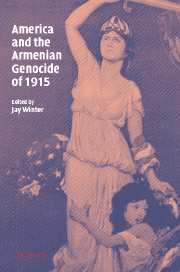Book contents
- Frontmatter
- Contents
- List of contributors
- Map
- Acknowledgments
- Introduction: witness to genocide
- Part 1 The framework
- Part II During the Catastrophe
- 4 A friend in power? Woodrow Wilson and Armenia
- 5 Wilsonian diplomacy and Armenia: the limits of power and ideology
- 6 American diplomatic correspondence in the age of mass murder: the Armenian Genocide in the US archives
- 7 The Armenian Genocide and American missionary relief efforts
- 8 Mary Louise Graffam: witness to genocide
- 9 From Ezra Pound to Theodore Roosevelt: American intellectual and cultural responses to the Armenian Genocide
- Part III After the Catastrophe
- Index
- Studies in the Social and Cultural History of Modern Warfare
8 - Mary Louise Graffam: witness to genocide
Published online by Cambridge University Press: 04 September 2009
- Frontmatter
- Contents
- List of contributors
- Map
- Acknowledgments
- Introduction: witness to genocide
- Part 1 The framework
- Part II During the Catastrophe
- 4 A friend in power? Woodrow Wilson and Armenia
- 5 Wilsonian diplomacy and Armenia: the limits of power and ideology
- 6 American diplomatic correspondence in the age of mass murder: the Armenian Genocide in the US archives
- 7 The Armenian Genocide and American missionary relief efforts
- 8 Mary Louise Graffam: witness to genocide
- 9 From Ezra Pound to Theodore Roosevelt: American intellectual and cultural responses to the Armenian Genocide
- Part III After the Catastrophe
- Index
- Studies in the Social and Cultural History of Modern Warfare
Summary
Introduction
On 14 August 1901, Mary Louise Graffam, a shy teacher from the National Cathedral School for Girls in Washington, D.C., left Boston for a new life as an educational missionary for the American Board of Commissioners for Foreign Missions (ABCFM) in Ottoman Turkey. She embarked on what promised to be a fairly conventional missionary career as the head of Female Education in the Near Eastern mission post of Sivas, an established American mission station. Little did she know that she would be thrust, instead, into the horrors of twentieth-century warfare and would become a first-hand witness to genocide conducted by a government against a portion of its own people.
The story of Mary Louise Graffam deserves to be told at the beginning of a new century replete with possibilities for the development of new forms of evil. As the only American to stay with Armenians at her mission in eastern Turkey throughout the First World War, Graffam occupies a unique position in history. Her commentary provides a direct and powerful testimony about the history of modern genocide. Surprisingly, no serious account, let alone major biography, of Graffam has ever appeared, despite the existence of numerous unpublished documents, oral and written histories in Armenian, scattered primary source materials as well as general works on the Armenian Genocide and missionary history that mention her heroic resistance to the massacres.
- Type
- Chapter
- Information
- America and the Armenian Genocide of 1915 , pp. 214 - 239Publisher: Cambridge University PressPrint publication year: 2004
- 1
- Cited by

